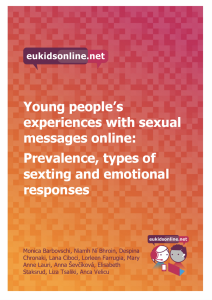Reports & Summaries
Young people’s experiences with sexual messages online
 Full Article Name: Young People’s Experiences with Sexual Messages Online: Prevalence, Types of Sexting and Emotional Responses
Full Article Name: Young People’s Experiences with Sexual Messages Online: Prevalence, Types of Sexting and Emotional Responses
Open Access: Yes
Abstract
This report presents findings from the latest EU Kids Online survey conducted in 19 countries between 2017 and 2019 (Smahel et al., 2020). 14,598 adolescents aged 12 to 17 answered questions related to online sexual messages.
An average of 22% of all young people report receiving sexual messages in the past year, while 6% report sending or posting sexts themselves. Almost 4% requested sexual information from others. 13% were asked for sexual information about themselves but did not want to answer. Results show that youth who engage in active sexting (i.e., exchanges where young people initiate the communication, by sending, requesting, or posting sexts online) live in less positive home and school environments, but tend to find online spaces safer for connection and expression (including sexual communication).
Research to date has primarily investigated sending and posting sexual messages and images as feminine behaviour (or being ”a girl thing”). However, we find that boys were more likely than girls to send, post, and request sexual messages in the countries included in our survey. Girls at all ages tend to be significantly more upset about receiving sexual messages than boys.
Recipients of unwanted sexual messages tend to be girls, older, and display a preference for online communication. They are also more likely to experience cyber-victimisation, report more sensation-seeking, feel less safe in their homes and online, and have more emotional symptoms. Our findings suggest that receiving these requests is not an isolated online problem and may be associated with an increased risk of exposure to other forms of victimization. Practitioners working with adolescents should therefore be aware of the need to acknowledge unwanted sexual requests. They should also understand the need to probe a possible cooccurrence of negative experiences with online interaction, and, if needed, to develop plans for reducing adolescents´ vulnerability and tendency to become targets of disrespectful behaviour online.
Relevant sexual education is needed to ensure that young people develop skills including critical and informed responses to sexualized digital communication. We recommend steering away from education about sexting that is grounded in fear. School-based sexual education should instead be expanded to include issues of sexuality, privacy and consent related to existing practices of sexting.
Citation
Barbovschi, M., Ni Bhroin, N., Chronaki, D., Cibocci, L., Farrugia, L., Lauri, M-A., Ševčíková, A., Staksrud, E., Tsaliki, L., & Velicu, A. (2021). Young people’s experiences with sexual messages online: Prevalence, types of sexting and emotional responses across European countries. EU Kids Online and the Department of Media and Communication. http://urn.nb.no/URN:NBN:no-91296

